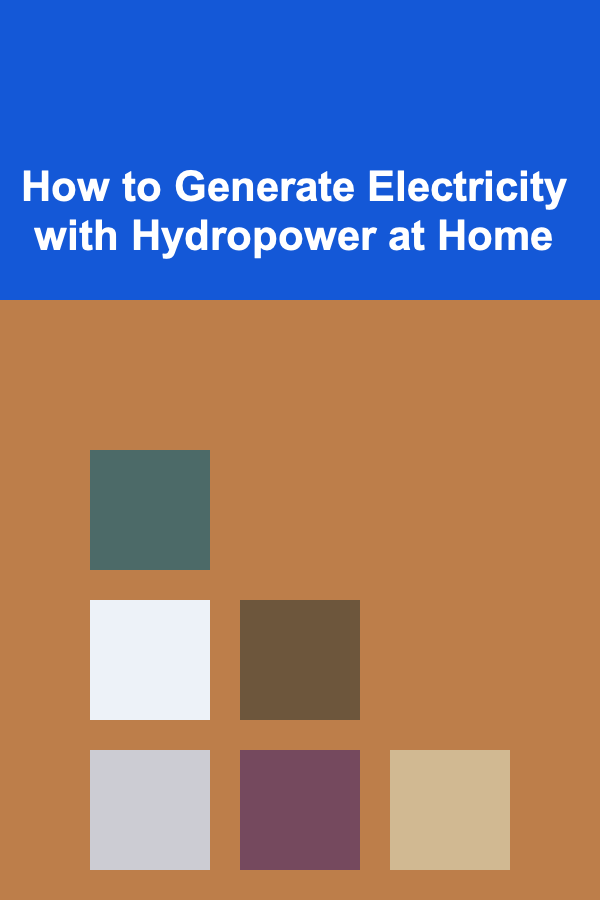
How to Generate Electricity with Hydropower at Home
ebook include PDF & Audio bundle (Micro Guide)
$12.99$11.99
Limited Time Offer! Order within the next:

Hydropower is one of the oldest and most effective methods of generating electricity, relying on the natural force of flowing water to turn turbines that produce energy. As the world transitions to renewable energy sources, hydropower stands out as a reliable and sustainable solution for home energy production. While large-scale hydropower plants are commonly used to generate electricity for communities and cities, it is also possible to harness the power of water for residential use. In this article, we will explore how you can generate electricity with hydropower at home, covering everything from understanding the basics of hydropower to the steps and considerations needed to set up your own home hydropower system.
Understanding Hydropower
Hydropower works by using the energy of flowing or falling water to generate mechanical power, which is then converted into electricity using a turbine and a generator. The basic principle is simple: as water flows, its kinetic energy is captured, typically through a water wheel or turbine, and converted into rotational energy that drives a generator to produce electricity.
Types of Hydropower Systems
There are three main types of hydropower systems:
- Storage Hydropower: Water is stored in a reservoir behind a dam and released when needed to generate electricity.
- Run-of-River Hydropower: This system uses the natural flow of a river to generate electricity without the need for a large reservoir.
- Pumped Storage Hydropower: This system stores energy by pumping water from a lower reservoir to a higher one, using electricity during off-peak hours. The water is then released to generate electricity during peak hours.
For residential purposes, most home hydropower systems fall under the run-of-river category, where the natural flow of a nearby stream or river is harnessed.
Assessing the Feasibility of Hydropower at Home
Before considering setting up a hydropower system at home, it is essential to evaluate whether it is feasible for your location and specific needs. Several factors influence the viability of a home hydropower system, including the available water source, its flow rate, and the geography of the land.
2.1 Water Source and Flow
The key factor in generating electricity through hydropower is having access to a reliable water source, such as a stream, river, or waterfall. The water needs to flow consistently and have enough energy to turn a turbine efficiently. If you have access to a stream with a consistent flow, you may be able to use it for hydropower generation.
To assess the flow of water, you need to measure:
- Flow Rate (Cubic Feet per Second): The rate at which the water flows is crucial. A higher flow rate allows for more energy production. You will need to determine if your stream or river has enough flow to generate the electricity you need.
- Head (Height Difference): The height difference between the water source and where the energy is to be generated is called the "head." A greater head will generate more power. For example, a waterfall with a significant height difference is ideal for hydropower.
2.2 Geography and Site Evaluation
The terrain and geography of your property will also influence the installation of a hydropower system. You will need a slope or elevation change that allows the water to flow downwards, which will help generate more energy. This also means evaluating whether the location allows for the installation of a pipeline or channel to direct the water flow to the turbine.
2.3 Environmental and Legal Considerations
When setting up a hydropower system at home, it is essential to consider environmental factors and local regulations. In many areas, water rights, ecological impact, and permits are important issues that need to be addressed.
Before starting any hydropower project, you should:
- Research local water rights laws to ensure that you are allowed to use the water source for electricity generation.
- Consider the impact on local wildlife. Redirecting or altering the flow of water can disrupt local ecosystems, so it is essential to ensure that the project does not harm the environment.
- Obtain permits: In many regions, you may need to obtain permits for installing a hydropower system, particularly if the installation involves altering the natural course of a river or stream.
Components of a Home Hydropower System
Once you have assessed the feasibility of using hydropower at home, you need to consider the key components required to generate electricity. A typical home hydropower system consists of several major components:
3.1 Water Intake System
The water intake system diverts water from the stream or river into a pipeline or channel that leads to the turbine. This system needs to filter out debris and prevent clogging. It typically includes:
- Screening Device: To prevent large debris from entering the system.
- Penstock or Pipeline: The pipe that carries the water from the intake to the turbine. The larger the pipe, the more water can flow through it, increasing the system's capacity.
3.2 Turbine
The turbine is the heart of the hydropower system. As water flows over the turbine blades, it causes them to spin, converting the kinetic energy of the water into mechanical energy. There are several types of turbines, including:
- Pelton Wheel: Best for high-head systems (high elevation drops).
- Francis Turbine: Suitable for medium-head systems.
- Kaplan Turbine: Ideal for low-head, high-flow systems.
Choosing the right type of turbine is crucial for optimizing your system's efficiency based on the flow rate and head of your water source.
3.3 Generator
The generator is responsible for converting the mechanical energy from the turbine into electrical energy. It operates similarly to a standard electric generator but is driven by the turbine's rotation rather than an external engine. The generator's size will depend on how much electricity you intend to generate.
3.4 Control System
The control system is used to manage the electricity output and ensure the system operates efficiently. It may include:
- Voltage Regulators: To ensure that the electricity output is consistent and safe for use in your home.
- Switchgear: To control the flow of electricity and disconnect the system in case of malfunction or maintenance.
3.5 Transmission and Storage
Once the electricity is generated, it needs to be transmitted to your home. This is usually done through an inverter, which converts the generated direct current (DC) electricity into alternating current (AC) electricity, which is used in homes.
If your system generates more electricity than you can use, you may want to include battery storage to store excess energy for later use, or you may choose to feed it back into the grid, if applicable.
Setting Up a Home Hydropower System
4.1 Planning and Design
The first step in setting up a home hydropower system is to carefully design the system based on your site's specific characteristics. You'll need to determine the size and capacity of each component, such as the turbine and generator, based on the flow rate and head of your water source.
Additionally, you'll need to decide where to place the intake, turbine, generator, and control system to ensure optimal performance. A detailed design should also include safety measures and environmental considerations.
4.2 Installation Process
- Build the Intake System: Construct the intake system to divert water from the river or stream. Make sure the intake is properly screened and filtered to avoid debris clogging the system.
- Install the Penstock: Lay the penstock to direct water to the turbine. Make sure the pipe is large enough to carry enough water to generate electricity.
- Set Up the Turbine: Install the turbine at the base of the water flow, ensuring that it is properly aligned with the water flow to maximize efficiency.
- Install the Generator and Control Systems: Set up the generator to convert mechanical energy into electrical energy, and install any necessary control systems to regulate voltage and ensure safe operation.
4.3 Testing and Calibration
Once the system is installed, it is essential to test and calibrate it to ensure it is operating efficiently. Test the water flow, turbine performance, and electricity output. Make adjustments as needed to optimize the system's performance.
Maintenance and Longevity of the System
A well-maintained hydropower system can last for many years, but regular maintenance is necessary to ensure it continues to operate efficiently. Common maintenance tasks include:
- Cleaning the intake system to prevent debris build-up.
- Inspecting the penstock for leaks or blockages.
- Checking the turbine and generator for wear and tear.
- Monitoring the electrical system to ensure proper output and voltage.
Conclusion
Generating electricity with hydropower at home is an environmentally friendly and cost-effective way to reduce your dependence on the grid and harness the natural power of flowing water. While setting up a hydropower system requires careful planning and consideration of several factors, it can provide a reliable source of renewable energy for your household. By understanding the basic principles of hydropower, assessing the feasibility of your location, and carefully selecting the right components, you can create a sustainable energy solution that benefits both your home and the environment.
Reading More From Our Other Websites
- [Personal Care Tips 101] How to Achieve Healthy, Glowing Skin with the Right Body Wash
- [Home Renovating 101] How to Landscape Your Backyard: Ideas for Creating an Outdoor Oasis
- [Soap Making Tip 101] From Kitchen to Bath: Simple Soap Recipes Using Everyday Ingredients
- [Home Lighting 101] How to Light a Gallery Wall or Artwork?
- [Beachcombing Tip 101] Historical Treasures: The Story Behind Vintage Sea Glass Pieces
- [Home Staging 101] How to Stage a Small Apartment to Maximize Space
- [Organization Tip 101] How to Create a System for Managing Family Calendars
- [Home Renovating 101] How to Plan a Deck Building and Renovation Project Around Existing Built-in Storage
- [Biking 101] Top 5 Indoor Cycling Gear You Need for an Effective Workout
- [Organization Tip 101] How to Organize Your School Supply Shelf at Home

How to Start a Family Book Club with Engaging Reads
Read More
How to Track and Analyze Customer Lifetime Value (CLV) for Market Insights
Read More
How To Understand the Importance of Seagrass Beds
Read More
How to Explain Compound Interest to Kids
Read More
10 Tips for Prioritizing Your School To-Do List
Read More
How to Make Seed Bead Earrings: A Step-by-Step Guide for Beginners
Read MoreOther Products

How to Start a Family Book Club with Engaging Reads
Read More
How to Track and Analyze Customer Lifetime Value (CLV) for Market Insights
Read More
How To Understand the Importance of Seagrass Beds
Read More
How to Explain Compound Interest to Kids
Read More
10 Tips for Prioritizing Your School To-Do List
Read More